The Forest Change Footprint of the Upper Indus Valley, from 1990 to 2020
Abstract
:1. Introduction
2. Materials and Methods
2.1. Study Area
2.2. Data Preprocessing
2.3. Forest Change Footprint Information Extraction
2.3.1. Built Mask for Forest/Non-Forest Areas
2.3.2. Detection Methods for Forest Disturbance and Recovery
2.3.3. Classification of Forest Disturbance and Recovery Levels
2.3.4. Accuracy Assessment
- HGFC was produced by the Global Land Analysis and Discovery Laboratory at the University of Maryland, in partnership with the Global Forest Watch, and provides annually updated global-scale forest loss data derived using Landsat time-series imagery (https://storage.googleapis.com/earthenginepartners-hansen/GFC-2020-v1.8/download.html, accessed on 10 December 2021)[9]. This dataset was generated based on multi-source remote sensing data, such as Landsat and MODIS from 2000 to 2020, combined with bagged decision tree classification methods. In contrast to the Hansen product, we extended the time to 1990 and used a change detection algorithm based on spectral-temporal segmentation, a near-automated change detection algorithm that has the advantage of requiring less input data and having a high-detection efficiency compared to the classification method. We downloaded and synthesized HGFC data from 2000 to 2020 for validation, including the disturbance and recovery bands.
- Validation samples were obtained through visual interpretation of high-resolution Google Earth historical images.
3. Results
3.1. Spatial and Temporal Patterns of Forest Disturbance and Recovery
3.2. Temporal and Spatial Characteristics of Different Levels of Disturbance and Recovery
3.3. Accuracy Assessment of LandTrendr Results
4. Discussion
4.1. Forest Disturbance and Recovery in Different Regions
4.2. Analysis of the Causes of Disturbance and Recovery
4.3. Method Limitations and Its Application
5. Conclusions
Author Contributions
Funding
Institutional Review Board Statement
Informed Consent Statement
Data Availability Statement
Conflicts of Interest
References
- Bala, G.; Caldeira, K.; Wickett, M.; Phillips, T.J.; Lobell, D.B.; Delire, C.; Mirin, A. Combined climate and carbon-cycle effects of large-scale deforestation. Proc. Natl. Acad. Sci. USA 2007, 104, 6550–6555. [Google Scholar] [CrossRef] [PubMed] [Green Version]
- Bonan, G.B. Forests and climate change: Forcings, feedbacks, and the climate benefits of forests. Science 2008, 320, 1444–1449. [Google Scholar] [CrossRef] [PubMed] [Green Version]
- Mondal, P.; McDermid, S.S.; Qadir, A. A reporting framework for Sustainable Development Goal 15: Multi-scale monitoring of forest degradation using MODIS, Landsat and Sentinel data. Remote Sens. Environ. 2020, 237, 111592. [Google Scholar] [CrossRef]
- Attiwill, P.M. The disturbance of forest ecosystems—The ecological basis for conservative management. For. Ecol. Manag. 1994, 63, 247–300. [Google Scholar] [CrossRef]
- Seidl, R.; Fernandes, P.M.; Fonseca, T.F.; Gillet, F.; Jonsson, A.M.; Merganicova, K.; Netherer, S.; Arpaci, A.; Bontemps, J.D.; Bugmann, H.; et al. Modelling natural disturbances in forest ecosystems: A review. Ecol. Model. 2011, 222, 903–924. [Google Scholar] [CrossRef] [Green Version]
- Munoz, R.; Bongers, F.; Rozendaal, D.M.A.; Gonzalez, E.J.; Dupuy, J.M.; Meave, J.A. Autogenic regulation and resilience in tropical dry forest. J. Ecol. 2021, 109, 3295–3307. [Google Scholar] [CrossRef]
- Vina, A.; McConnell, W.J.; Yang, H.B.; Xu, Z.C.; Liu, J.G. Effects of conservation policy on China’s forest recovery. Sci. Adv. 2016, 2, 1500965. [Google Scholar] [CrossRef] [Green Version]
- Chen, Y.; Luo, G.; Maisupova, B.; Chen, X.; Mukanov, B.M.; Wu, M.; Mambetov, B.T.; Huang, J.; Li, C. Carbon budget from forest land use and management in Central Asia during 1961–2010. Agric. For. Meteorol. 2016, 221, 131–141. [Google Scholar] [CrossRef]
- Hansen, M.C.; Potapov, P.V.; Moore, R.; Hancher, M.; Turubanova, S.A.; Tyukavina, A.; Thau, D.; Stehman, S.V.; Goetz, S.J.; Loveland, T.R.; et al. High-resolution global maps of 21st-century forest cover change. Science 2013, 342, 850–853. [Google Scholar] [CrossRef] [Green Version]
- Immerzeel, W.W.; Lutz, A.F.; Andrade, M.; Bahl, A.; Biemans, H.; Bolch, T.; Hyde, S.; Brumby, S.; Davies, B.J.; Elmore, A.C.; et al. Importance and vulnerability of the world’s water towers. Nature 2020, 577, 364–369. [Google Scholar] [CrossRef]
- FAO. State of the World’s Forests 2011; Food and Agricultural Organization of the United Nations: Rome, Italy, 2011. [Google Scholar]
- Rashid, I.; Bhat, M.A.; Romshoo, S.A. Assessing changes in the above ground biomass and carbon stocks of Lidder valley, Kashmir Himalaya, India. Geocarto Int. 2017, 32, 717–734. [Google Scholar] [CrossRef]
- Zeb, A.; Hamann, A.; Armstrong, G.W.; Acuna-Castellanos, D. Identifying local actors of deforestation and forest degradation in the Kalasha valleys of Pakistan. For. Policy Econ. 2019, 104, 56–64. [Google Scholar] [CrossRef]
- Masek, J.G.; Huang, C.Q.; Wolfe, R.; Cohen, W.; Hall, F.; Kutler, J.; Nelson, P. North American forest disturbance mapped from a decadal Landsat record. Remote Sens. Environ. 2008, 112, 2914–2926. [Google Scholar] [CrossRef]
- Griffiths, P.; Kuemmerle, T.; Baumann, M.; Radeloff, V.C.; Abrudan, I.V.; Lieskovsky, J.; Munteanu, C.; Ostapowicz, K.; Hostert, P. Forest disturbances, forest recovery, and changes in forest types across the Carpathian ecoregion from 1985 to 2010 based on Landsat image composites. Remote Sens. Environ. 2014, 151, 72–88. [Google Scholar] [CrossRef]
- Pflugmacher, D.; Cohen, W.B.; Kennedy, R.E.; Yang, Z.Q. Using Landsat-derived disturbance and recovery history and lidar to map forest biomass dynamics. Remote Sens. Environ. 2014, 151, 124–137. [Google Scholar] [CrossRef]
- Joshi, A.K.; Joshi, P.K.; Chauhan, T.; Bairwa, B. Integrated approach for understanding spatio-temporal changes in forest resource distribution in the central Himalaya. J. For. Res. 2014, 25, 281–290. [Google Scholar] [CrossRef]
- Qamer, F.M.; Shehzad, K.; Abbas, S.; Murthy, M.S.R.; Xi, C.; Gilani, H.; Bajracharya, B. Mapping Deforestation and Forest Degradation Patterns in Western Himalaya, Pakistan. Remote Sens. 2016, 8, 385. [Google Scholar] [CrossRef] [Green Version]
- Gorelick, N.; Hancher, M.; Dixon, M.; Ilyushchenko, S.; Thau, D.; Moore, R. Google Earth Engine: Planetary-scale geospatial analysis for everyone. Remote Sens. Environ. 2017, 202, 18–27. [Google Scholar] [CrossRef]
- Huang, C.; Coward, S.N.; Masek, J.G.; Thomas, N.; Zhu, Z.; Vogelmann, J.E. An automated approach for reconstructing recent forest disturbance history using dense Landsat time series stacks. Remote Sens. Environ. 2010, 114, 183–198. [Google Scholar] [CrossRef]
- Verbesselt, J.; Hyndman, R.; Newnham, G.; Culvenor, D. Detecting trend and seasonal changes in satellite image time series. Remote Sens. Environ. 2010, 114, 106–115. [Google Scholar] [CrossRef]
- Hughes, M.J.; Kaylor, S.D.; Hayes, D.J. Patch-Based Forest Change Detection from Landsat Time Series. Forests 2017, 8, 166. [Google Scholar] [CrossRef]
- Deng, C.B.; Zhu, Z. Continuous subpixel monitoring of urban impervious surface using Landsat time series. Remote Sens. Environ. 2020, 238, 21. [Google Scholar] [CrossRef]
- Zhu, Z.; Zhang, J.; Yang, Z.; Aljaddani, A.H.; Cohen, W.B.; Qiu, S.; Zhou, C. Continuous monitoring of land disturbance based on Landsat time series. Remote Sens. Environ. 2020, 238, 11116. [Google Scholar] [CrossRef]
- Nature, W.W.F.f. As the World’s Population Grows, Forests Are Coming under More Pressure Than Ever. Available online: https://www.wwfpak.org/our_work_/forests/ (accessed on 18 December 2021).
- Roy, D.P.; Kovalskyy, V.; Zhang, H.K.; Vermote, E.F.; Yan, L.; Kumar, S.S.; Egorov, A. Characterization of Landsat-7 to Landsat-8 reflective wavelength and normalized difference vegetation index continuity. Remote Sens. Environ. 2016, 185, 57–70. [Google Scholar] [CrossRef] [Green Version]
- Zhu, Z.; Wang, S.; Woodcock, C.E. Improvement and expansion of the Fmask algorithm: Cloud, cloud shadow, and snow detection for Landsats 4–7, 8, and Sentinel 2 images. Remote Sens. Environ. 2015, 159, 269–277. [Google Scholar] [CrossRef]
- Zhu, Z.; Woodcock, C.E.; Olofsson, P. Continuous monitoring of forest disturbance using all available Landsat imagery. Remote Sens. Environ. 2012, 122, 75–91. [Google Scholar] [CrossRef]
- Yan, X.; Wang, J. Dynamic monitoring of urban built-up object expansion trajectories in Karachi, Pakistan with time series images and the LandTrendr algorithm. Sci. Rep. 2021, 11, 1–15. [Google Scholar] [CrossRef]
- Kennedy, R.E.; Yang, Z.G.; Cohen, W.B. Detecting trends in forest disturbance and recovery using yearly Landsat time series: 1. LandTrendr-Temporal segmentation algorithms. Remote Sens. Environ. 2010, 114, 2897–2910. [Google Scholar] [CrossRef]
- Kennedy, R.E.; Yang, Z.; Gorelick, N.; Braaten, J.; Cavalcante, L.; Cohen, W.B.; Healey, S. Implementation of the LandTrendr Algorithm on Google Earth Engine. Remote Sens. 2018, 10, 691. [Google Scholar] [CrossRef] [Green Version]
- Cohen, W.B.; Yang, Z.; Heale, S.P.; Kennedy, R.E.; Gorelic, N. A LandTrendr multispectral ensemble for forest disturbance detection. Remote Sens. Environ. 2018, 205, 131–140. [Google Scholar] [CrossRef]
- Lopez-Garcia, M.; Caselles, V. Mapping burns and natural reforestation using Thematic Mapper data. Geocarto Int. 1991, 6, 31–37. [Google Scholar] [CrossRef]
- Wilson, E.H.; Sader, S.A. Detection of forest harvest type using multiple dates of Landsat TM imagery. Remote Sens. Environ. 2002, 80, 385–396. [Google Scholar] [CrossRef]
- Tucker, C.J. red and photographic infrared linear combinations for monitoring vegetation. Remote Sens. Environ. 1979, 8, 127–150. [Google Scholar] [CrossRef] [Green Version]
- Salomonson, V.V.; Appel, I. Estimating fractional snow cover from MODIS using the normalized difference snow index. Remote Sens. Environ. 2004, 89, 351–360. [Google Scholar] [CrossRef]
- Huete, A.; Didan, K.; Miura, T.; Rodriguez, E.P.; Gao, X.; Ferreira, L.G. Overview of the radiometric and biophysical performance of the MODIS vegetation indices. Remote Sens. Environ. 2002, 83, 195–213. [Google Scholar] [CrossRef]
- Huang, C.; Wylie, B.; Yang, L.; Homer, C.; Zylstra, G. Derivation of a tasselled cap transformation based on Landsat 7 at-satellite reflectance. Int. J. Remote Sens. 2002, 23, 1741–1748. [Google Scholar] [CrossRef]
- Crist, E.P. A Tm Tasseled Cap Equivalent Transformation for Reflectance Factor Data. Remote Sens. Environ. 1985, 17, 301–306. [Google Scholar] [CrossRef]
- Baig, M.H.A.; Zhang, L.; Shuai, T.; Tong, Q. Derivation of a tasselled cap transformation based on Landsat 8 at-satellite reflectance. Remote Sens. Lett. 2014, 5, 423–431. [Google Scholar] [CrossRef]
- Liu, S.; Wei, X.; Li, D.; Lu, D. Examining Forest Disturbance and Recovery in the Subtropical Forest Region of Zhejiang Province Using Landsat Time-Series Data. Remote Sens. 2017, 9, 479. [Google Scholar] [CrossRef] [Green Version]
- Pathania, M.S.; Sharma, S.K. Impact of migratory animals on grazing lands: An evidence from Himachal Pradesh. Indian J. Anim. Res. 2012, 46, 40–45. [Google Scholar]
- Shah, S.; Sharma, D.P. Land use change detection in Solan Forest Division, Himachal Pradesh, India. Forest Ecosystems 2015, 2, 327–338. [Google Scholar] [CrossRef] [Green Version]
- Sharma, P.; Mahajan, A.; Lata, K.; Bharti, H.; Randhawa, S.S. An Analysis of the Temporal Changes in the Forests of Himachal Pradesh—A Review; State Centre on Climate Change State Council for Science: Shimla, India, 2015; Volume 10, pp. 63–76. [Google Scholar]
- Nandy, S.; Singh, C.; Das, K.K.; Kingma, N.C.; Kushwaha, S.P.S. Environmental vulnerability assessment of eco-development zone of Great Himalayan National Park, Himachal Pradesh, India. Ecol. Indic. 2015, 57, 182–195. [Google Scholar] [CrossRef]
- Khan, M.I.; Hussain, S.K.; Saad, H.; Rukh, G.; Ahmed, M.M.; Ahmad, I. Third Party Monitoring of Billion Trees Afforestation Project in Khyber Pakhtunkhwa Phase-Ii; World Wide Fund for Nature Pakistan (WWF-Pakistan): Lahore, Pakistan, 2017. [Google Scholar]
- Khan, I.A.; Khan, M.R.; Baig, M.H.A.; Hussain, Z.; Hameed, N.; Khan, J.A. Assessment of forest cover and carbon stock changes in sub-tropical pine forest of Azad Jammu & Kashmir (AJK), Pakistan using multi-temporal Landsat satellite data and field inventory. PLoS ONE 2020, 15, e0226341. [Google Scholar] [CrossRef] [Green Version]
- Hislop, S.; Jones, S.; Soto-Berelov, M.; Skidmore, A.; Haywood, A.; Nguyen, T.H. A fusion approach to forest disturbance mapping using time series ensemble techniques. Remote Sens. Environ. 2019, 221, 188–197. [Google Scholar] [CrossRef]

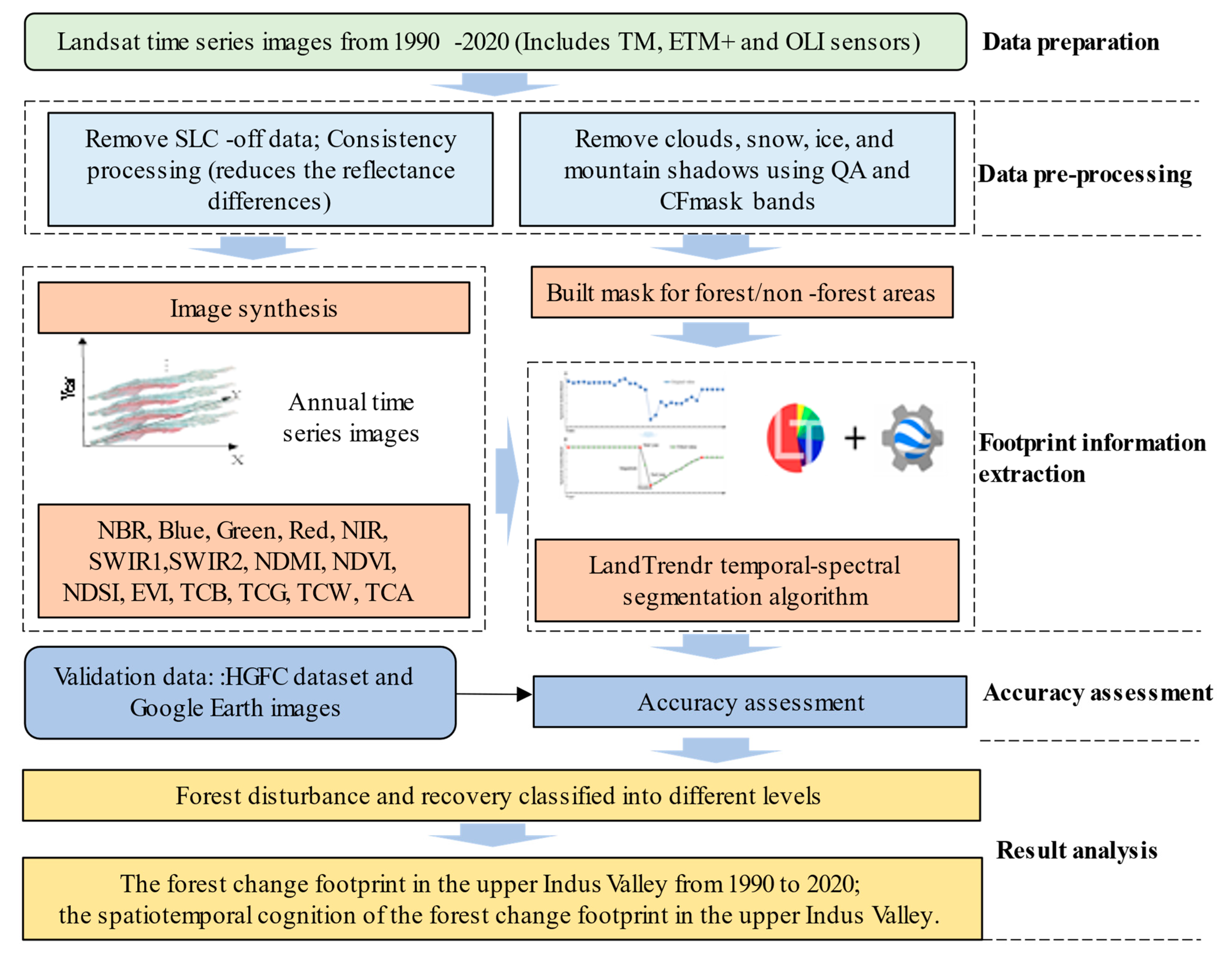

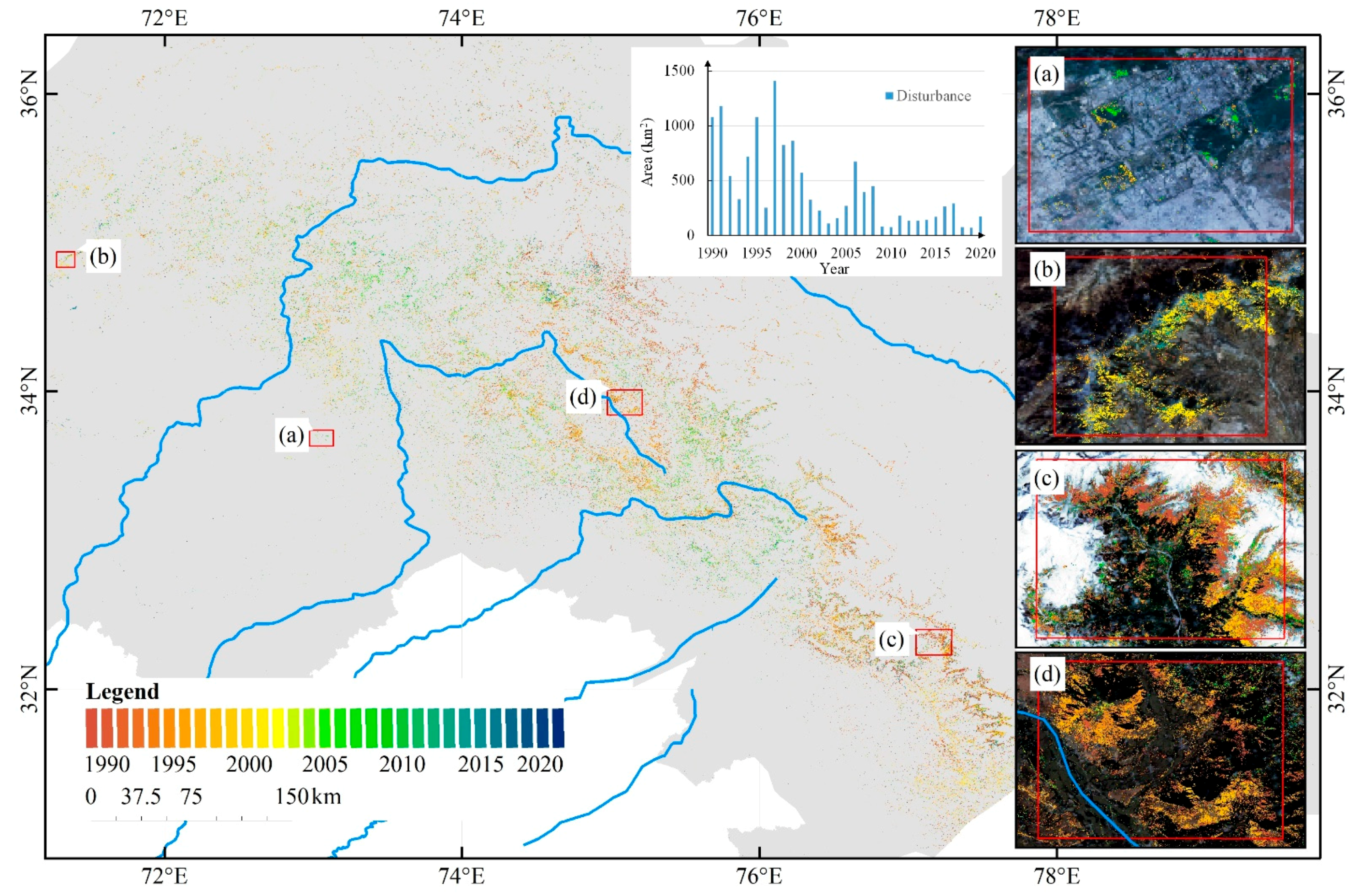
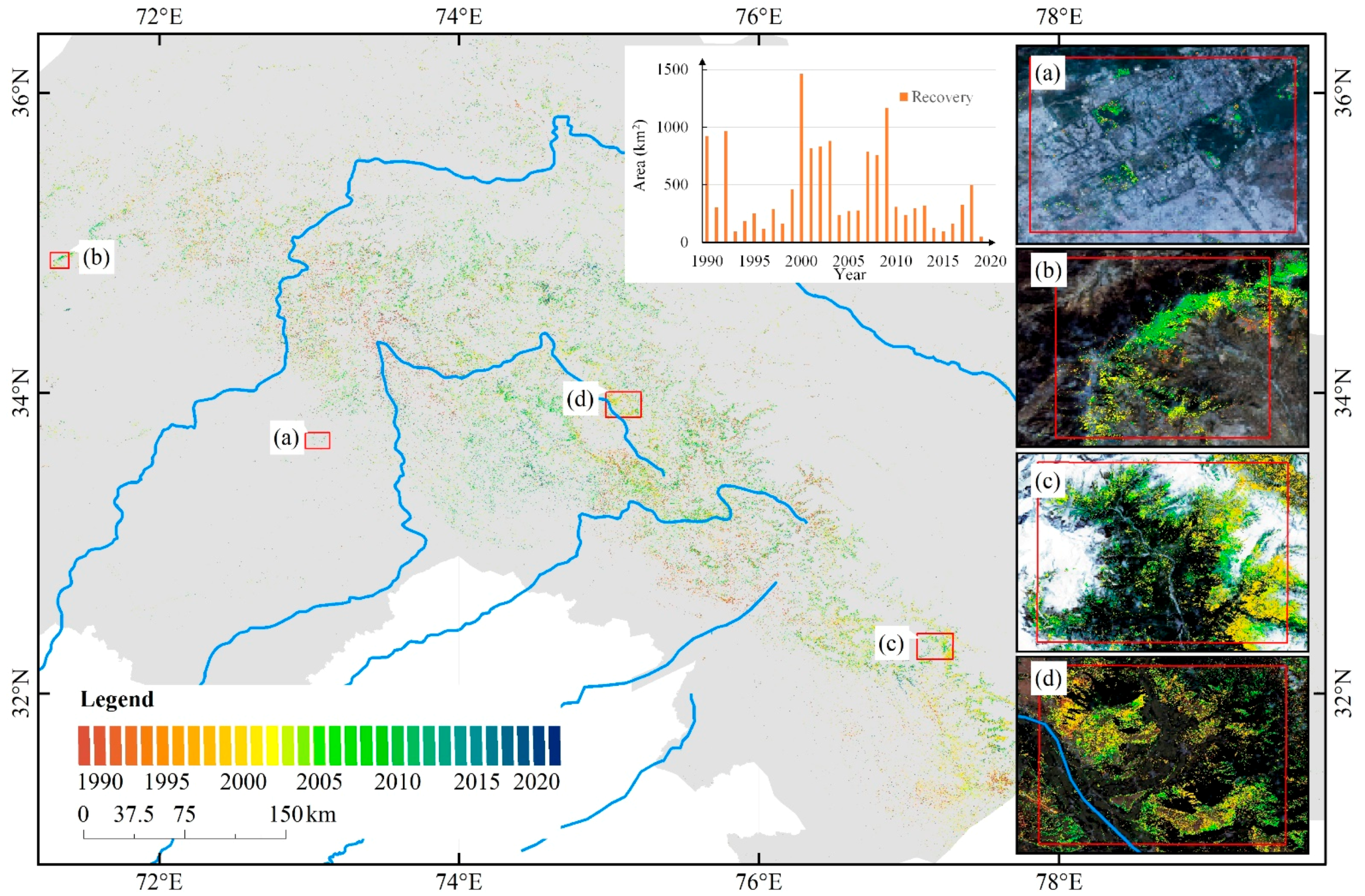
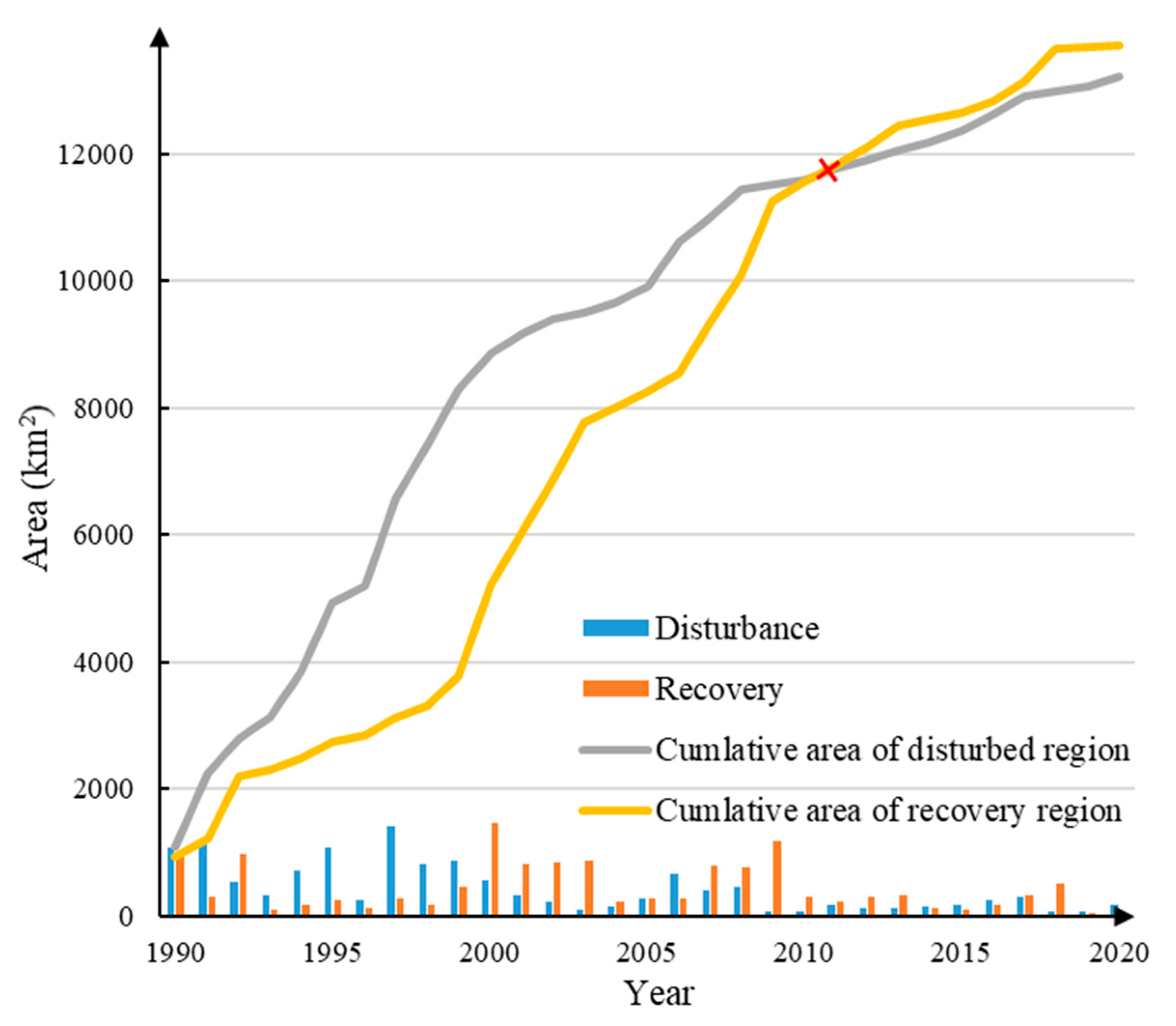
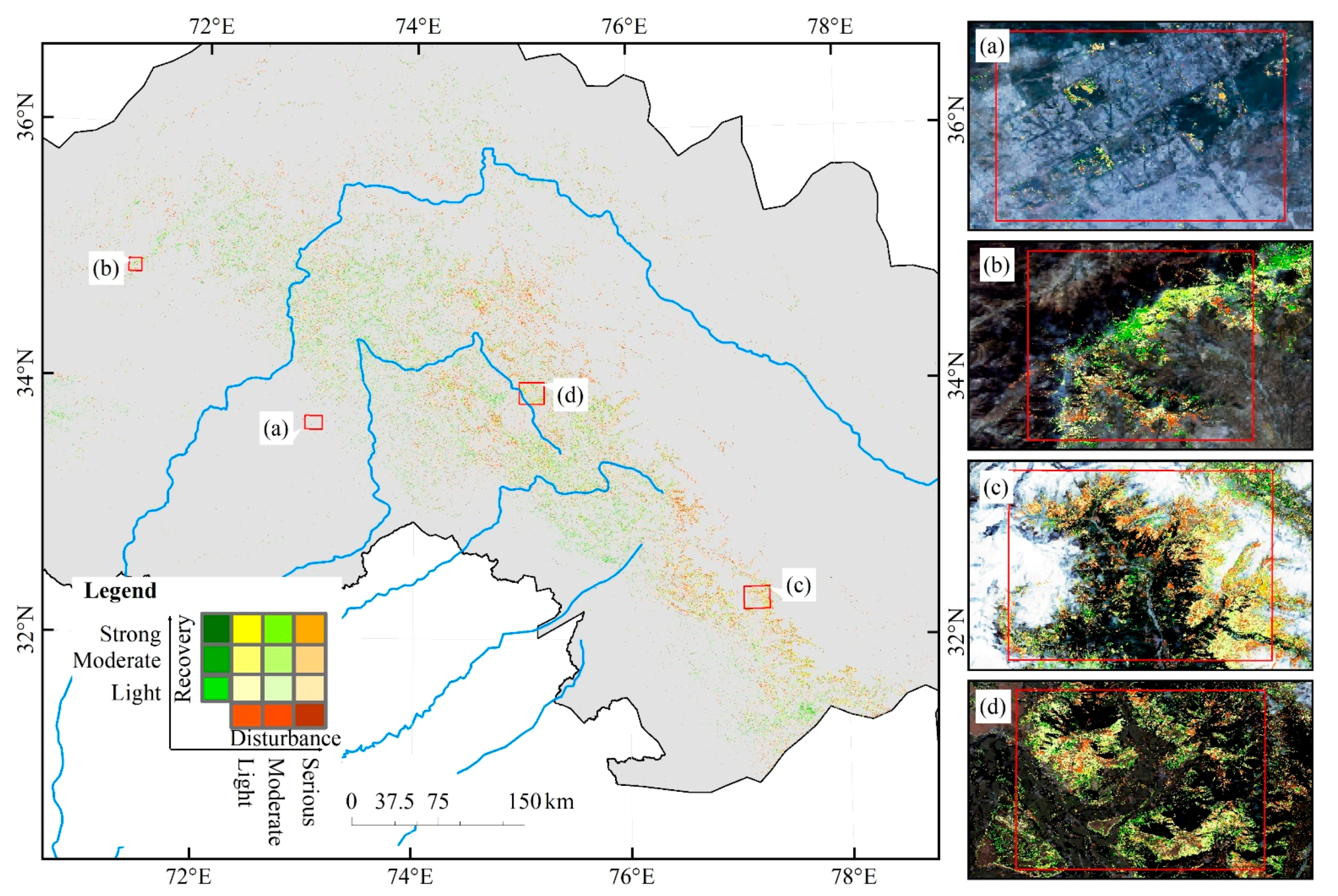
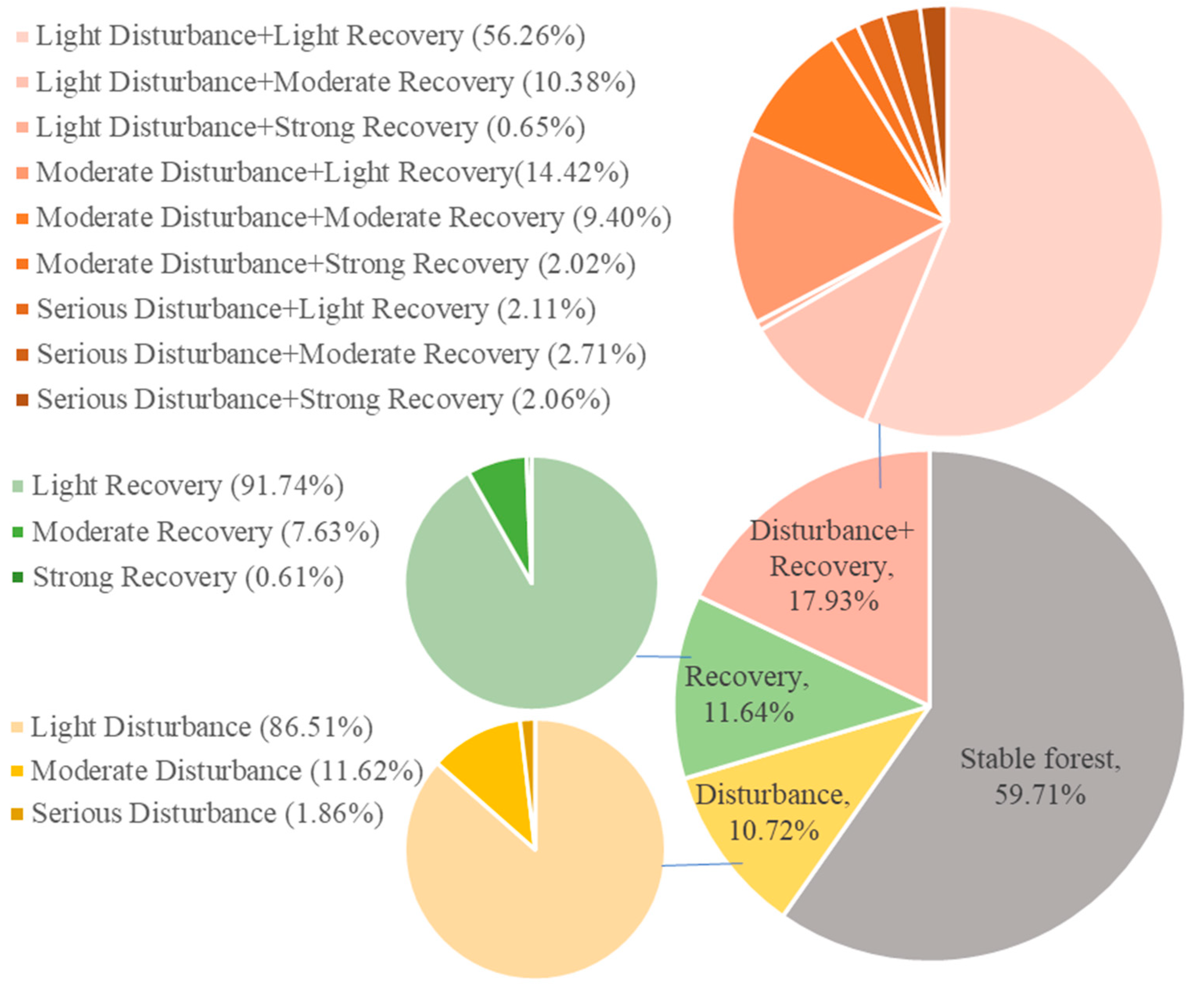
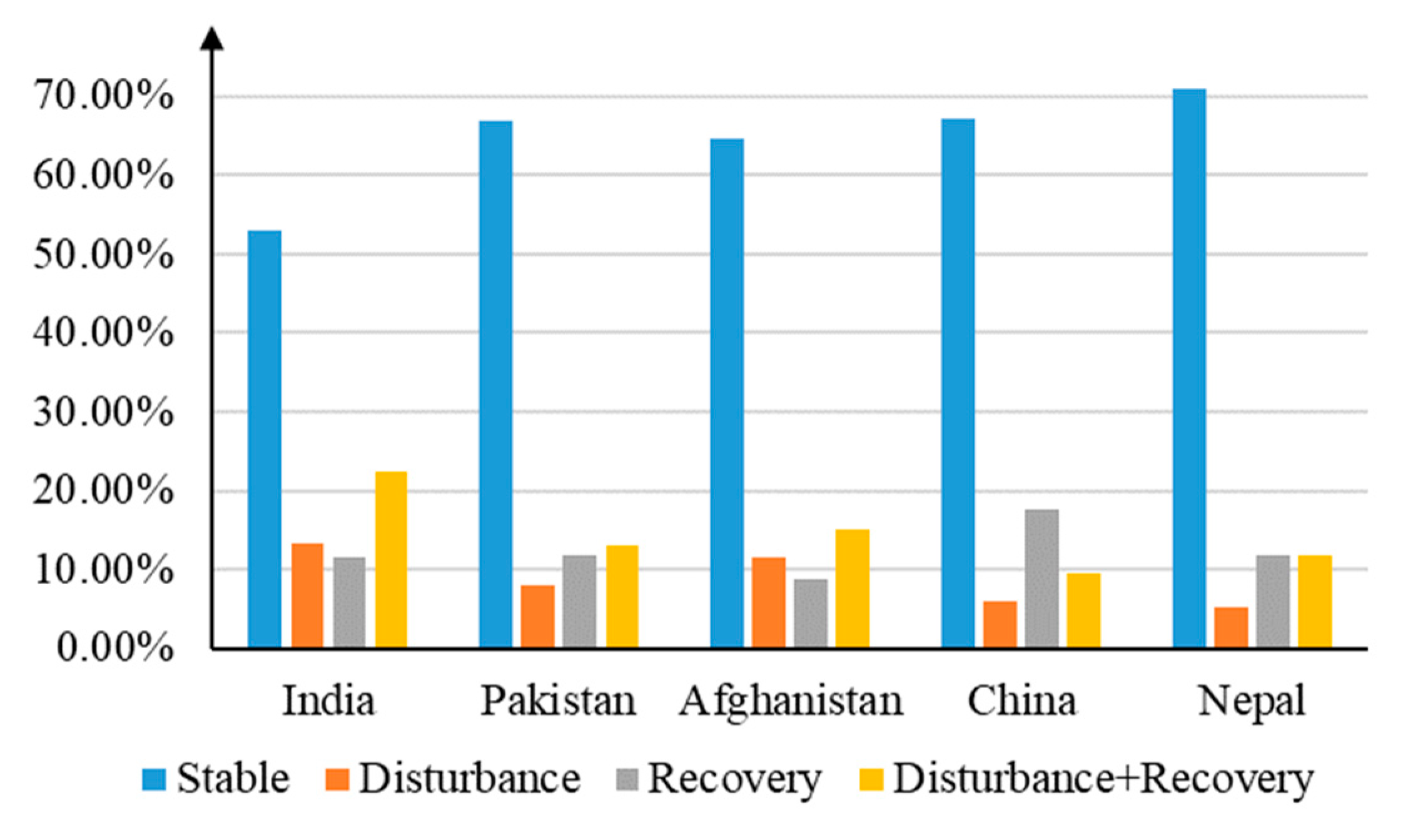

| Name | Data Source | Data Description |
|---|---|---|
| Landsat time-series remote sensing image | USGS, filter and synthesize on GEE | A total of 8203 remote sensing images were used, path and row as shown in Figure 1. |
| Google Earth image | Google Earth Pro Software | Assist in determining thresholds for different levels of disturbance and recovery; collect samples for accuracy assessment. |
| Hansen Global Forest Change datasets v1.8 (2000–2020) (HGFC) [9] | University of Maryland | Results from time-series analysis of Landsat images in characterizing global forest extent and change from 2000 through 2020. The data are used for an accuracy assessment. |
| Band/Index Name | Description | Calculate Method | Reference |
|---|---|---|---|
| Blue, Green, Red, NIR, SWIR1, SWIR2 | Original bands from the TM, ETM+, and OLI. | The SLC-off data were removed, and the harmonization function [26] was used for consistency processing along with ETM+ and OLI data to obtain the annual sequence images of six bands. | / |
| Normalized burn ratio (NBR) | Normalized difference indices generated by TM, ETM+, and OLI sensors. | NBR = (NIR-SWIR2)/(NIR+SWIR2) | [33] |
| Normalized difference moisture index (NDMI) | Normalized difference indices generated by TM, ETM+, and OLI sensors. | NDMI = (NIR-SWIR1)/(NIR+SWIR1) | [34] |
| Normalized difference vegetation index (NDVI) | Normalized difference indices generated by TM, ETM+, and OLI sensors. | NDVI = (NIR-Red)/(NIR+Red) | [35] |
| Normalized difference snow index (NDSI) | Normalized difference indices generated by TM, ETM+, and OLI sensors. | NDSI = (Green-SWIR1)/(Green+SWIR1) | [36] |
| Enhanced vegetation index (EVI) | A vegetation index calculated from three bands of TM, ETM+, and OLI sensors. | EVI = 2.5 * ((NIR - Red)/(NIR + 6 * Red - 7.5 * Blue + 1)) | [37] |
| Tasseled cap brightness (TCB) | It is derived from spectral data and the tasselled-cap transformation algorithm. The algorithm can compress spectral data into several bands of physical scene features with minimal information loss. | TCB = 0.2043(Blue) + 0.4158(Green) + 0.5524(Red) + 0.5741(NIR) + 0.3124(SWIR1) + 0.2303(SWIR2) | [38,39,40] |
| Tasseled cap greenness (TCG) | TCG = −0.1603(Blue) − 0.2819(Green) − 0.4934(Red)) + 0.7940(NIR) − 0.0002(SWIR1) − 0.1446(SWIR2) | ||
| Tasseled cap wetness (TCW) | TCW = 0.0315(Blue) + 0.2021(Green) + 0.3102(Red)) + 0.1594(NIR) − 0.6806(SWIR1) − 0.6109(SWIR2) | ||
| Tasseled cap wetness (TCA) | TCA = arctan (TCB/TCG) |
| Type | Level | Description | Thresholds |
|---|---|---|---|
| Disturbance | Serious | Land use type changes, deforestation, and forest fires caused complete changes in the surface; for example, the transition from forests to agricultural land and buildings. | 500 < magnitude |
| Moderate | Due to different reasons such as selective logging, drought, or pests and diseases, the forest has been severely disturbed. | 350 < magnitude ≤ 500 | |
| Light | Local changes in the forest, forest disturbances can be reflected in high-resolution images, such as plenter-thinning in the management process. | 200 < magnitude ≤ 350 | |
| Recovery | Strong | The transition from non-forest land use types to forest types is mainly through afforestation, and areas with better climate conditions can also be self-regulated or community succession through forest ecosystems. | <−500 |
| Moderate | The opposite process of moderate disturbance indicates the change of forest structure, such as the change from sparse forest to dense forest. | −500 ≤magnitude < −350 | |
| Light | Due to afforestation or self-recovery of forests, the density of forest structure gradually becomes higher, which can be observed in high-resolution images. | −350 ≤magnitude < −200 |
| Reference Data: HGFC Datasets (Pixels) | |||||
|---|---|---|---|---|---|
| Disturbance | Recovery | Disturbance + Recovery | User Accuracy | ||
| LandTrendr results (pixels) | Disturbance | 7265 | 593 | 65 | 91.69% |
| Recovery | 1014 | 4617 | 29 | 81.57% | |
| Disturbance + Recovery | 250 | 83 | 623 | 65.16% | |
| Producer accuracy | 85.18% | 87.22% | 86.88% | ||
| Overall accuracy | 86.01% | ||||
| Kappa | 0.73 | ||||
| Reference Data: Google Earth Images (Pixels) | |||||
|---|---|---|---|---|---|
| Disturbance | Recovery | Disturbance + Recovery | User Accuracy | ||
| LandTrendr results (pixels) | Disturbance | 1520 | 107 | 61 | 90.05% |
| Recovery | 35 | 633 | 36 | 89.91% | |
| Disturbance + Recovery | 100 | 102 | 837 | 80.56% | |
| Producer accuracy | 91.84% | 61.86% | 89.61% | ||
| Overall accuracy | 87.17% | ||||
| Kappa | 0.79 | ||||
| Region | Forest Area | Stable | Disturbance | Recovery | Disturbance + Recovery |
|---|---|---|---|---|---|
| India | 23,345.81 | 12,368.8 (52.98%) | 3078.08 (13.18%) | 2664.1 (11.41%) | 5234.9 (22.42%) |
| Pakistan | 20,366.96 | 13,640.44 (66.97%) | 1646.3 (8.08%) | 2405.44 (11.81%) | 2678.15 (13.15%) |
| Afghanistan | 1463.67 | 945.44 (64.59%) | 167.42 (11.44%) | 128.88 (8.81%) | 221.41 (15.13%) |
| China | 1009.24 | 626.36 (62.06%) | 60.09 (5.95%) | 176.51 (17.49%) | 146.25 (14.49%) |
| Nepal | 6.57 | 4.67 (71.03%) | 0.35 (5.33%) | 0.77 (11.74%) | 0.78 (11.89%) |
| Forest Management Country | Province | Forest Area | Stable | Disturbance | Recovery | Recovery − Disturbance |
|---|---|---|---|---|---|---|
| Afghanistan | Bamian | 0.32 | 0.21 | 0.10 | 0.07 | −0.02 |
| Badakhshan | 10.10 | 7.43 | 1.53 | 2.21 | 0.68 | |
| Baghlan | 17.48 | 11.75 | 4.91 | 3.53 | −1.38 | |
| Ghazni | 0.17 | 0.06 | 0.10 | 0.07 | −0.02 | |
| Kabol | 4.89 | 2.31 | 1.19 | 2.21 | 1.02 | |
| Kapisa | 59.49 | 41.02 | 12.22 | 13.12 | 0.90 | |
| Konarha | 920.04 | 627.05 | 212.51 | 209.93 | −2.58 | |
| Laghman | 132.28 | 100.70 | 21.86 | 20.38 | −1.47 | |
| Lowgar | 8.22 | 4.53 | 1.76 | 3.20 | 1.44 | |
| Nangarhar | 102.24 | 56.92 | 34.70 | 27.47 | −7.23 | |
| Paktia | 124.15 | 50.63 | 64.76 | 43.06 | −21.70 | |
| Paktika | 22.67 | 6.49 | 15.08 | 7.61 | −7.47 | |
| Parvan | 42.82 | 26.51 | 11.63 | 11.29 | −0.34 | |
| Takhar | 0.01 | 0.01 | 0.00 | 0.00 | 0.00 | |
| Vardak | 18.79 | 10.08 | 6.69 | 6.32 | −0.37 | |
| China | Xinjiang | 9.18 | 6.10 | 2.60 | 1.76 | −0.84 |
| Xizang | 1000.05 | 620.26 | 203.74 | 321.00 | 117.26 | |
| India | Himachal Pradesh | 8259.54 | 3997.95 | 3423.46 | 3060.69 | −362.77 |
| Haryana | 0.10 | 0.03 | 0.06 | 0.06 | 0.00 | |
| Jammu and Kashmir | 14,960.13 | 8318.08 | 4831.74 | 4784.82 | −46.92 | |
| Punjab | 11.70 | 4.83 | 4.24 | 5.87 | 1.63 | |
| Uttar Pradesh | 114.34 | 47.71 | 53.43 | 47.49 | −5.93 | |
| Nepal | Karnali | 6.57 | 4.67 | 1.13 | 1.55 | 0.42 |
| Pakistan | Azad Kashmir | 4517.45 | 3036.43 | 948.27 | 1117.16 | 168.89 |
| Federally Administered Tribal Areas | 1017.79 | 734.91 | 160.99 | 234.34 | 73.35 | |
| Gilgit Baltistan | 4248.70 | 2689.32 | 1126.95 | 1086.06 | −40.89 | |
| Khyber Pakhtunkhwa | 10,073.75 | 6802.69 | 2002.93 | 2539.98 | 537.05 | |
| Punjab | 509.27 | 374.69 | 84.74 | 105.21 | 20.47 | |
| Total | 46,192.26 | 27,583.36 | 4952.12 | 5375.30 | 423.18 |
Publisher’s Note: MDPI stays neutral with regard to jurisdictional claims in published maps and institutional affiliations. |
© 2022 by the authors. Licensee MDPI, Basel, Switzerland. This article is an open access article distributed under the terms and conditions of the Creative Commons Attribution (CC BY) license (https://creativecommons.org/licenses/by/4.0/).
Share and Cite
Yan, X.; Wang, J. The Forest Change Footprint of the Upper Indus Valley, from 1990 to 2020. Remote Sens. 2022, 14, 744. https://doi.org/10.3390/rs14030744
Yan X, Wang J. The Forest Change Footprint of the Upper Indus Valley, from 1990 to 2020. Remote Sensing. 2022; 14(3):744. https://doi.org/10.3390/rs14030744
Chicago/Turabian StyleYan, Xinrong, and Juanle Wang. 2022. "The Forest Change Footprint of the Upper Indus Valley, from 1990 to 2020" Remote Sensing 14, no. 3: 744. https://doi.org/10.3390/rs14030744
APA StyleYan, X., & Wang, J. (2022). The Forest Change Footprint of the Upper Indus Valley, from 1990 to 2020. Remote Sensing, 14(3), 744. https://doi.org/10.3390/rs14030744







